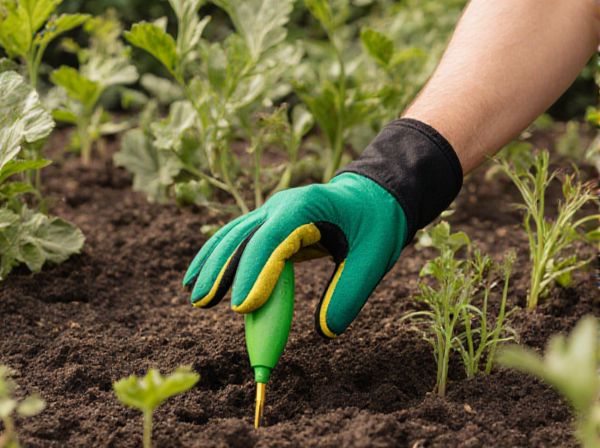
Suckers vs Slips Illustration
Suckers emerge from the roots of a parent plant, producing genetically identical shoots that can spread rapidly but may weaken the original plant by diverting nutrients. Slips are stem cuttings taken from a mature plant, used for propagation to create new, independent plants with established growth potential. Both methods offer efficient propagation, but slips generally provide a more controlled and reliable means of cultivating healthy plants.
Table of Comparison
| Propagation Method | Suckers | Slips |
|---|---|---|
| Definition | New shoots emerging from roots or base of the parent plant | Cuttings taken from stem or branch to root independently |
| Origin | Naturally formed from underground roots | Manually cut and planted segments |
| Rooting Time | Faster due to existing root system | Slower; requires rooting hormone or suitable conditions |
| Genetic Identity | Clonal; identical to parent plant | Clonal; maintains genetic traits of parent |
| Labor Intensity | Low; naturally occurring shoots | High; requires cutting and care for rooting |
| Suitability | Best for plants prone to suckering like fruit trees | Ideal for propagating hardwood and semi-hardwood species |
| Survival Rate | High due to established root access | Moderate; depends on care and environment |
Introduction to Propagation: Suckers vs Slips
Suckers and slips represent two common vegetative propagation methods in horticulture, offering reliable ways to reproduce plants genetically identical to the parent. Suckers emerge as shoots from the root system or base of a plant, often requiring careful removal to prevent unwanted spreading, while slips are stem cuttings taken from the parent plant to encourage root development after planting. Understanding the differences in origin and application of suckers versus slips is crucial for effective plant propagation and maintaining desired plant traits.
Understanding Suckers: Definition and Characteristics
Suckers are shoots that emerge from the root system or lower trunk of a plant, often arising from adventitious buds below the graft union. These vigorous, fast-growing stems typically have weaker structural integrity and can divert nutrients from the main plant, reducing overall vigor and fruit production. Understanding suckers is essential in propagation to ensure plant health and maintain desired cultivar traits by timely removal and monitoring.
Slips Explained: What Makes Them Unique?
Slips are specialized plant cuttings taken from young, tender shoots, typically from grasses or sugarcane, that root quickly due to their high moisture content and active growth points. Unlike suckers, which emerge naturally from the base or roots of the parent plant, slips are manually separated, offering a controlled method for propagation that ensures genetic consistency. Their rapid rooting ability and ease of transplanting make slips a preferred choice for efficient and large-scale cultivation.
Key Differences Between Suckers and Slips
Suckers are shoots that emerge from roots or underground stems, often occurring naturally or accidentally and capable of developing into new plants genetically identical to the parent. Slips, on the other hand, are intentionally cut or detached segments of stems or branches used in propagation to create clones through rooting or grafting. The key difference lies in their origin: suckers arise spontaneously from root systems, whereas slips are purposefully taken from the parent plant for propagation purposes.
Advantages of Propagating with Suckers
Propagating with suckers offers advantages such as strong genetic consistency and robust root systems, ensuring healthier and more vigorous plant growth compared to slips. Suckers establish quicker in new environments due to their developed rootstock, providing higher survival rates and reduced transplant shock. This method also allows for cost-effective propagation without the need for specialized cutting techniques or extensive care.
Benefits of Using Slips for Multiplication
Slips offer faster establishment compared to suckers, allowing quicker root development and plant growth. They provide higher uniformity in offspring, ensuring consistent crop quality and yield. Using slips reduces labor intensity since they are easier to handle and plant, making multiplication more efficient for large-scale propagation.
Ideal Plants for Sucker Propagation
Ideal plants for sucker propagation include raspberries, blackberries, and certain types of fruit trees like apples and cherries, as their root systems naturally produce vigorous suckers. These suckers develop from the base or roots, ensuring genetic consistency with the parent plant and promoting strong, healthy new growth. Sucker propagation is especially effective for plants that readily generate shoots underground, allowing for easy transplanting and rapid establishment.
Best Plants Suited for Slip Propagation
Slip propagation works best with plants such as succulents, coleus, and geraniums due to their ability to root quickly from stem cuttings. These plants have high success rates because their stems contain ample moisture and nutrients, facilitating rapid root development. Using slips from healthy, disease-free parent plants increases the likelihood of successful propagation and vigorous growth.
Step-by-Step Guide: How to Propagate Using Suckers and Slips
Propagation through suckers involves identifying young shoots emerging from the base of the parent plant, carefully digging around the sucker to preserve roots, and transplanting it immediately into well-draining soil to encourage root establishment. For slips, detach healthy shoots with a few leaves from herbaceous plants, dip the cut ends in rooting hormone to stimulate root growth, and plant them in a moist medium such as peat or perlite, maintaining consistent humidity and warmth. Both methods require monitoring for new growth within weeks, ensuring optimal conditions like indirect sunlight and regular watering to maximize propagation success.
Common Mistakes and Tips for Successful Propagation
Common mistakes in propagation include confusing suckers with slips, as suckers are aggressive shoots arising from roots, while slips are stem cuttings used for cloning plants. Successful propagation requires identifying true slips by selecting healthy, disease-free stems with several nodes, avoiding root damage when removing suckers. To improve success rates, maintain consistent moisture levels, provide adequate humidity, and use rooting hormone to stimulate root development on slips.
Suckers vs Slips Infographic

 gardendif.com
gardendif.com